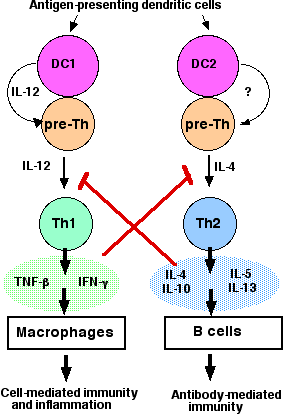Helper T cells
Helper T cells are T lymphocyte that belong to the CD4+ subset.
1. Types of Helper T Cells
- Th1 ; These participate in cell-mediated immunity. They are essential for controlling such intracellular pathogens as viruses and certain bacteria, e.g., Listeria and Mycobacterium tuberculosis (the bacillus that causes tb).
- Th2 ; These provide help for B cells and, in so doing, are essential for antibody-mediated immunity. Antibodies are needed to control extracellular pathogens (which — unlike intracellular parasites — are exposed to antibodies in blood and other body fluids).
2. Origin of Helper T Cells
Like all T cells, Th cells arise in the thymus.
- When they acquire CD4, they are called pre-Th cells.
- When they are presented with both an antigen and appropriate cytokines, they begin to proliferate and become activated.
- It is the nature of the stimulation that determines which path they enter: the path leading to Th1 cells or the path leading to Th2 cells.
The antigen-presenting cells (APCs) are called dendritic cells (DCs). There are several subsets of them: some produced by monocytes and others derived from a progenitor cell that gives rise to both them and monocytes.
Dendritic cells
- ingest antigen by phagocytosis or pinocytosis;
- degrade it in lysosomes, and
- display fragments of the antigen at their surface for presentation to T cells.
- secrete cytokines.
(Dendritic cells can also present intact antigen directly to B cells. In this case, the engulfed antigen is not degraded in lysosomes but is returned to the cell surface for presentation to B cells bearing BCRs of the appropriate specificity.)
There are at least two kinds of dendritic cell that present antigens to T cells:
- DC1 and DC2
1) Th1 Cells
Th1 cells are produced when DC1-type dendritic cells and pre-Th cells form an immunological synapse in which the dendritic cell
- presents antigen to the T cell's receptor for antigen (TCR);
- secretes interleukin 12 (IL-12).
The paracrine stimulation by IL-12 activates (through JAK-STAT pathways) the Th1 cells to secrete their own lymphokines:
- tumor-necrosis factor-beta (TNF-β) (also known as lymphotoxin) and
- interferon-gamma (IFN-γ)
These
- stimulate macrophages to kill the bacteria they have engulfed;
- recruit other leukocytes to the site producing inflammation.
